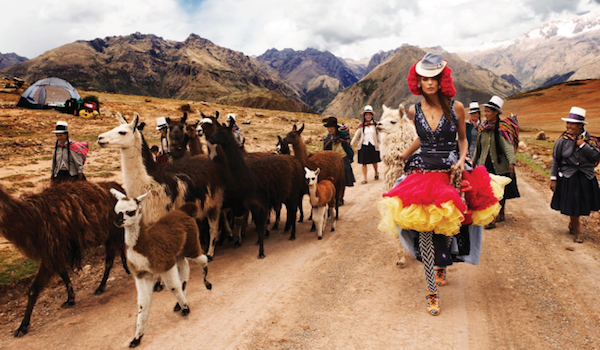
Fashion's Exotic Obsession

A white model stands among a group of ‘exotic’ non-white locals. She is dressed in this season’s fashionable get-up, visibly distinct from those who surround her. There may also be a couple of animals, and a palm tree thrown in for good measure. If you’ve ever flicked through a fashion magazine, you’ll know the type of shoot I’m referring to. But we’re not just talking about glamorous travelogues for Vogue in the 1950s, or the ‘exotic’ dreamscapes of the 1960s: you only have to look at Taylor Swift’s conjuring up of a colonial past in her Wildest Dreams video, or Valentino’s SS16 campaign to see a reworking of this trope. How did it become so well established? And what does its continued presence tell us about the western imagination today?

This specific type of fashion photography came to the fore not at the peak of colonial self-regard, but amidst post war austerity and instability. It was Norman Parkinson who first took 35mm film out of the studio, to photograph models in ‘exotic’ locations. When he began, Britain was bankrupt, rationing and travel restrictions were still in place, and the empire was decolonizing. His 1956 series in India, which appeared in British Vogue, is saturated with vibrant colours, set amidst beautiful ruins or on lakes with water-lilies in full bloom. The white model is effortlessly dressed in the height of western fashion, posing as a languorous women of leisure. It’s a very different story for the Indian people who accompany her, however. One man rows her boat, and for the cover photo, a young girl follows behind, carrying her parasol. These shoots in far-flung locations, displaying luxurious clothes and harking back to the Empire, are an imaginative opiate for the Spam readers in Blighty. They simultaneously present an outdated and orderly vision of a disintegrating empire, while also feeding aspirational dreams of leisure and surplus.

Diana Vreeland’s directorship at American Vogue increased the production of such images. As Alberto Oliva and Norberto Angeletti describe, “she considered the magazine a vast stage, on whose pages a spectacular show was taking place. And the stage had to have suitable sets and props. To provide them, she thought up fashion production locations at the most exotic places.” While theatricality and imaginative play are key elements of fashion photography, as Paul Jobling claims, it would be “myopic” to argue that fashion spreads: or that “a world of unbridled fantasies” are “innocent or without deeper ideological signification...”
You can read this article in full in Selvedge issue 71.
